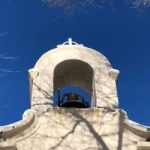Rejoice heart and soul, daughter of Zion! Shout with gladness, daughter of Jerusalem! See now, your king comes to you; he is victorious, he is triumphant, humble and riding on a donkey, on a colt, the foal of a donkey. ~ Zechariah 9:9 (Richard Rohr’s translation)
My family went to the United Methodist Church every Sunday. My sister and I sat safely sandwiched between Mom and Dad. Church was a quiet place where I could be still, listen to prayers and songs, and reflect on life. And if the sermon got too long, I could fall asleep on my dad’s shoulder, and he would wake me up when it was all over. The church was a warm family room.
I learned the rhythms of the liturgical year and eagerly anticipated the coming of Christmas with all the wonder and joy, and I looked forward to the promise of Easter and life everlasting. The Easter Egg hunt after church wasn’t half bad either. The church followed its own drumbeat.
I remember showing up on an early spring Sunday. Dr. Sewell, my dentist, and Mr. Neighbors, a car sales associate, whose wife was my English teacher, shook my hand, asked me how school was going, and gave me a palm branch. “What’s this?” I asked. “It’s Palm Sunday.”
“Huh, Palm Sunday?” This Sunday was not on my radar. Over the ensuing years, I learned to sing, “Hosanna in the highest!” I always thought it was peculiar that Jesus rode a donkey into Jerusalem, but I did not ask any questions. Palm Sunday was festive and happy. We waved our palm branches in church and sang praises to Jesus just like the adoring crowds did years ago when the Prince of Peace rode his donkey into the Holy City of Jerusalem.
I do not remember what those ministers of my youth said about Jesus riding a donkey into the Passover. I have read some disturbing things though. “With Roman soldiers lining the street, Jews gathered and waved palm branches, symbols of resistance to the empire. Passover was a volatile time, often marked by riots and bloodshed. Antipas killed thousands of Jews in the streets at the festival,” says Shane Claiborne in Jesus for President. This does not sound too festive to me. “Kings did not ride donkeys (a symbol of peace). They rode mighty war horses accompanied by an entourage of soldiers,” says Claiborne. “So here is Jesus making a spectacle of violence, riding in on the back of an ass. And a borrowed one at that.”
On Palm Sunday as a kid, I just remember waving palm branches and singing hosanna. Bright sunny spring days and Easter were around the corner. I also remember that I had a large heavy model of a B-29 bomber hanging from the ceiling of my bedroom. The Superfortress (B-29) was the plane used to drop the atomic bombs on Japan. The bomber made more sense to me as a vehicle for peace than Jesus riding a donkey.
Claiborne writes that President Harry Truman said, after dropping the atomic bomb on Nagasaki on January 9, 1945, “Having found the atomic bomb, we have used it. …It is an awful responsibility which has come to us. We thank God that it (the atomic bomb) has come to us instead of our enemies and we pray that he may guide us to use it in his way and for his purposes.”
So, what is the way of Jesus’ peace? Does God condone violence and dropping bombs for a higher good?
“Most of the slaughtering done throughout history has been done by people who sincerely believed they were promoting the good. Everyone thinks their wars are just, if not holy—Marxists, Nazis, Islamic terrorists, Christian crusaders,” says Claiborne. “And sadly, many of the horrific acts of terror and violence throughout history have been backed by scripture and distorted Christian theology. We only need look to Hitler holding the Bible or the KKK’s lynchings and flaming crosses.”
On Palm Sunday, Jesus rides into Jerusalem on a donkey. He is a quite different kind of king. “He is not an enthroned monarch or even a mounted warrior. He inaugurated a new kind of leadership—not based on dominative power, but one based on humble service,” writes Rohr. He leads through love, compassion, and respect for all life. He is willing to die for love and peace, but He does not kill, imprison, or intimidate people for a false peace. “The Jesus way shows that we need not battle violence with power and force, but with humility and revolutionary subordination. The entire Christian story demonstrates the triumph of love,” writes Claiborne.
When Jesus on his donkey sees the holy city of Jerusalem, he weeps and says, “If you, even you, had only recognized on this day the things that make for peace!” (see Luke 19:42). I believe when Jesus sees the holy city of Moscow, he weeps and says, “If you only knew on this day the things that make for peace!” I believe when the Living Christ sees the holy District of Columbia, he weeps and says, “If you, even you, had only recognized on this day the things that make for peace!”
Claiborne says, “Eventually we have to say ‘enough’. We repent and rethink the way our society has taught us to think.” What are the things that make for peace? Jesus died for peace, but he did not kill for it. There is a world of difference.
God creates us to love and be loved. May we receive that great gift and be blessed peacemakers in the Spirit of the one who rode a donkey into Jerusalem. Hosanna! Amen!
Blessings and peace,
Craig

